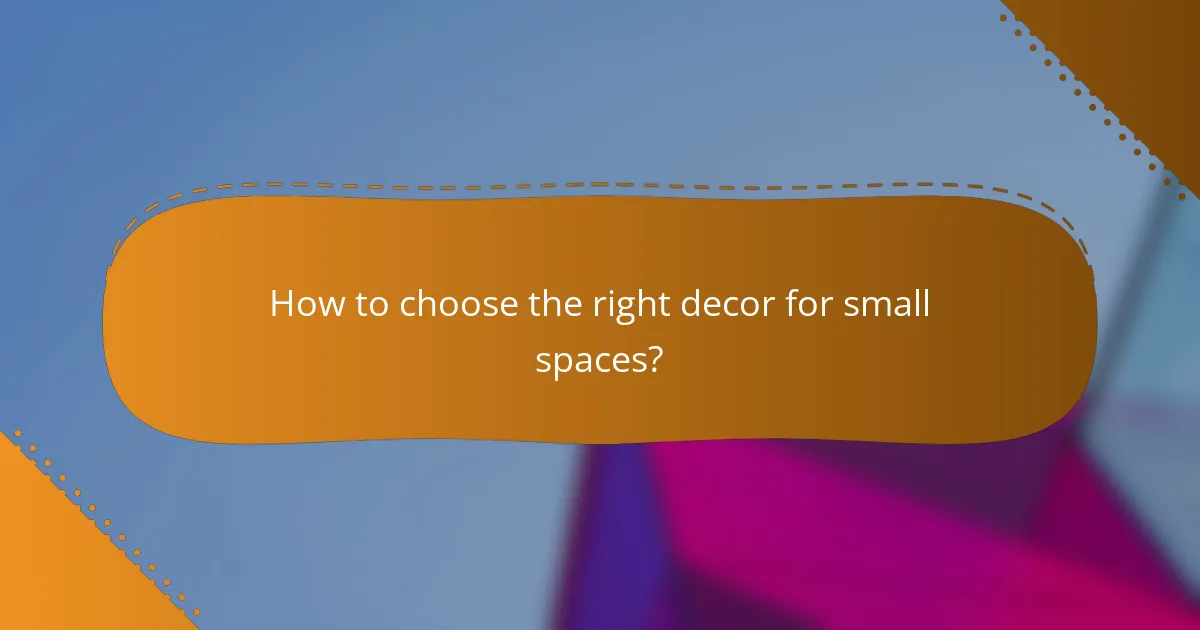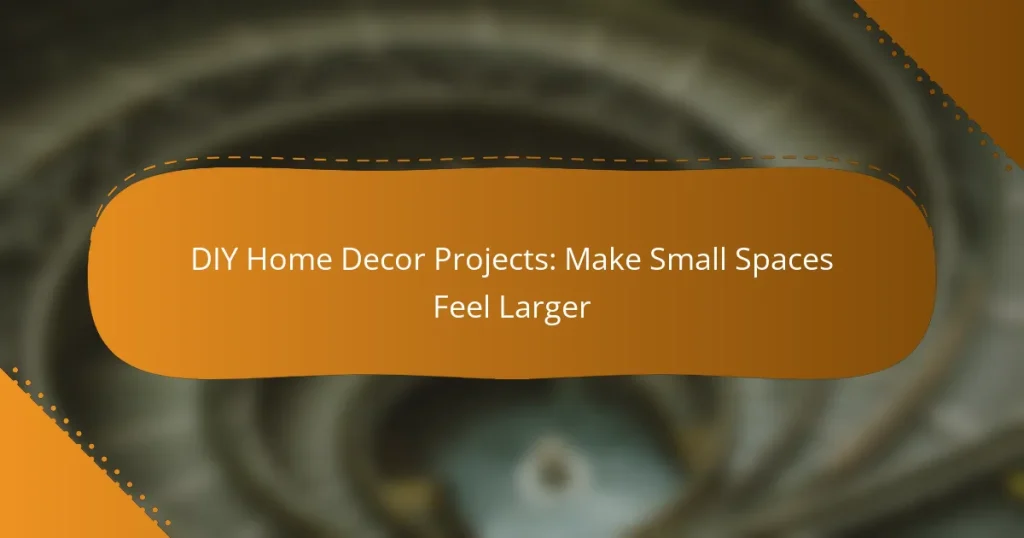Transforming small spaces into inviting and functional areas is achievable through clever DIY home decor projects. By incorporating techniques such as mirrors, light colors, and multi-functional furniture, you can create an illusion of spaciousness while enhancing the overall ambiance. Emphasizing vertical storage and strategic zoning further maximizes usability, making even the coziest corners feel open and welcoming.

How can DIY home decor make small spaces feel larger?
DIY home decor can effectively make small spaces feel larger by utilizing design techniques that enhance perception and functionality. By implementing strategic choices like mirrors, light colors, and multi-functional furniture, you can create an illusion of space and improve the overall ambiance of your home.
Use mirrors to create depth
Mirrors are a powerful tool for creating depth in small spaces. By reflecting light and images, they can make a room appear more expansive. Consider placing a large mirror on a wall opposite a window to maximize natural light and enhance the feeling of openness.
When selecting mirrors, opt for styles that complement your decor. Framed mirrors can add a decorative touch, while frameless options provide a sleek, modern look. Positioning mirrors at varying heights can also create visual interest and depth.
Incorporate light colors for walls
Using light colors on walls is a simple yet effective way to make small spaces feel larger. Soft shades of white, beige, or pastel colors can reflect light, making the room feel airy and open. Dark colors, on the other hand, tend to absorb light and can make a space feel more confined.
For a cohesive look, consider using the same light color for both walls and ceilings. This technique eliminates visual barriers and creates a seamless flow that enhances the sense of space. Additionally, using lighter colored furniture and decor can further amplify this effect.
Opt for multi-functional furniture
Multi-functional furniture is essential for maximizing space in small areas. Pieces that serve more than one purpose, such as a sofa bed or an ottoman with storage, can help reduce clutter and make the room feel more open. Look for furniture that can be easily moved or reconfigured to adapt to different needs.
When choosing multi-functional items, prioritize quality and style. Well-designed pieces not only save space but also enhance the overall aesthetic of your home. Avoid bulky furniture that takes up too much room; instead, focus on sleek designs that maintain a light and airy feel.

What are effective DIY projects for small spaces?
Effective DIY projects for small spaces focus on maximizing functionality and creating an illusion of more space. By utilizing vertical storage, multi-functional furniture, and strategic zoning, you can enhance the usability of compact areas.
Floating shelves for vertical storage
Floating shelves are an excellent way to utilize vertical space without taking up floor area. They can be installed in various rooms, such as living rooms, kitchens, or bathrooms, to display decor or store essentials.
When choosing floating shelves, consider materials that complement your existing decor, such as wood or metal. Ensure they are securely mounted to support the weight of items you plan to place on them.
- Install shelves at varying heights for visual interest.
- Use brackets for added support if needed.
- Keep items organized to avoid a cluttered appearance.
Wall-mounted desks for workspace
Wall-mounted desks are a smart solution for creating a workspace in small areas. They can be folded away when not in use, allowing for more floor space while providing a dedicated area for work or study.
When selecting a wall-mounted desk, look for designs that include built-in storage or shelves to maximize efficiency. Ensure the desk is at a comfortable height for working, typically around 28-30 inches from the floor.
- Choose a desk that matches your decor style.
- Consider adding a corkboard or pegboard above for organization.
- Ensure proper lighting to create an inviting workspace.
DIY room dividers for zoning
DIY room dividers can effectively create distinct areas within a small space, enhancing functionality and privacy. They can be made from various materials, including fabric, wood, or even plants, depending on your aesthetic preference.
When constructing a room divider, consider the height and width to ensure it fits well within your space. Lightweight options can be easily moved, while sturdier designs may provide more stability and sound absorption.
- Use curtains for a soft, flexible divider.
- Consider a bookshelf as a dual-purpose divider and storage solution.
- Incorporate plants for a natural touch and improved air quality.

What design principles enhance small spaces?
Design principles that enhance small spaces focus on creating an illusion of openness and maximizing functionality. Key strategies include emphasizing open floor plans, utilizing natural light, and maintaining a cohesive color palette.
Emphasize open floor plans
Open floor plans remove barriers between rooms, making small spaces feel larger and more inviting. By combining living, dining, and kitchen areas, you create a seamless flow that enhances spatial perception.
Consider using furniture arrangements that promote conversation and movement, such as a sectional sofa that defines the living area without blocking pathways. Avoid heavy partitions; instead, use rugs or furniture to delineate spaces.
Utilize natural light
Natural light is a powerful tool for making small spaces appear larger. Maximizing windows and using sheer curtains can help flood a room with light, creating a brighter and more open atmosphere.
In addition to window treatments, consider mirrors strategically placed to reflect light and views. A well-placed mirror can double the perceived space and enhance the overall brightness of the area.
Maintain a cohesive color palette
A cohesive color palette helps unify a small space, making it feel more expansive. Stick to light, neutral colors for walls and larger furniture pieces, as these shades tend to reflect light and create a sense of airiness.
Accent colors can be introduced through accessories like cushions, art, or decorative items. Aim for a limited number of colors to avoid visual clutter, which can overwhelm a small area.

How to choose the right decor for small spaces?
Choosing the right decor for small spaces involves selecting items that enhance the sense of openness while maintaining functionality. Focus on pieces that fit well within the dimensions of the room and contribute to a cohesive aesthetic without overwhelming the area.
Consider scale and proportion
When decorating small spaces, scale and proportion are crucial. Opt for furniture and decor that are appropriately sized; oversized pieces can make a room feel cramped. For example, a small sofa or a compact dining table can create a more spacious atmosphere compared to bulky alternatives.
Additionally, use vertical space effectively. Tall bookshelves or wall-mounted shelves draw the eye upward, creating an illusion of height. Mirrors can also enhance this effect by reflecting light and making the space appear larger.
Select space-saving accessories
Space-saving accessories are essential for maximizing functionality in small areas. Look for multi-purpose items, such as ottomans that double as storage or foldable tables that can be tucked away when not in use. These solutions help maintain an uncluttered environment.
Incorporate wall-mounted hooks or pegboards for organizing items without taking up floor space. This approach keeps essentials accessible while freeing up valuable room for movement.
Prioritize functionality over aesthetics
In small spaces, functionality should take precedence over purely aesthetic choices. Choose decor that serves a purpose, such as stylish storage solutions or furniture that can adapt to different needs. For instance, a coffee table with built-in storage can help keep the area tidy.
While aesthetics are important, ensure that each piece contributes to the overall usability of the space. Avoid decorative items that do not serve a function, as they can lead to clutter and diminish the room’s sense of openness.

What are common mistakes in small space decor?
Common mistakes in small space decor include overcrowding with furniture and ignoring vertical space. These errors can make a small area feel cramped and uninviting, hindering its potential for comfort and style.
Overcrowding with furniture
Overcrowding occurs when too much furniture is placed in a small area, leading to a cluttered and uncomfortable environment. To avoid this, select essential pieces that serve multiple functions, such as a sofa bed or an ottoman with storage.
Consider the scale of your furniture relative to the room size. Aim for fewer, larger items rather than many small pieces, which can create visual chaos. A good rule of thumb is to leave at least 24 inches of walking space between furniture pieces.
Ignoring vertical space
Ignoring vertical space can limit the functionality and aesthetic appeal of small areas. Utilizing walls for storage and decor can draw the eye upward, making the room feel larger. Install shelves, wall-mounted cabinets, or tall bookcases to maximize storage without sacrificing floor space.
Incorporate vertical elements like tall plants or artwork hung high on the walls to create an illusion of height. Mirrors can also enhance this effect; placing a large mirror opposite a window can reflect light and open up the space visually.


